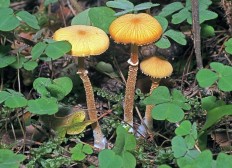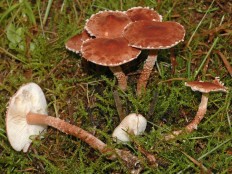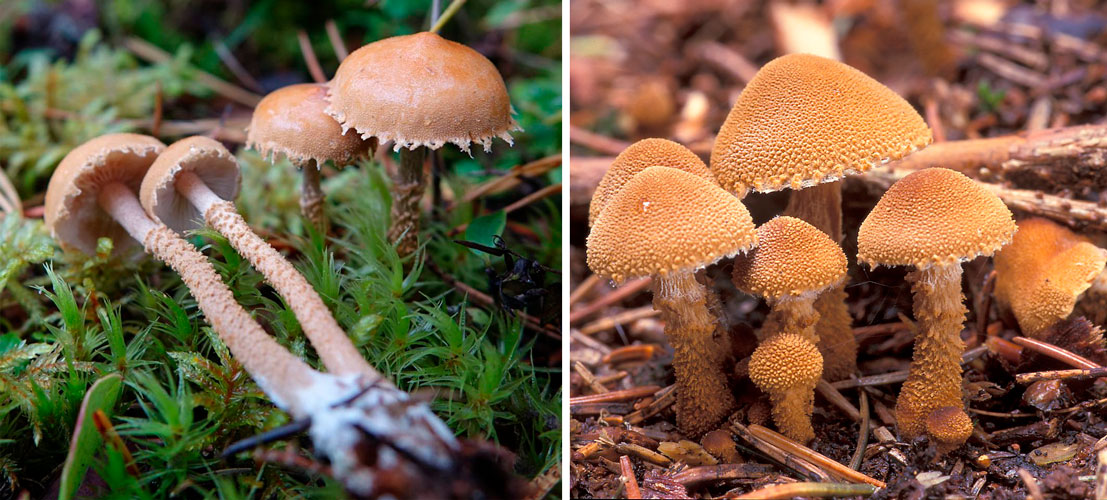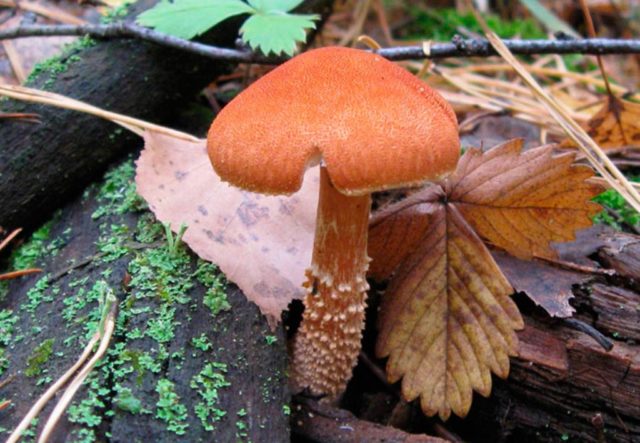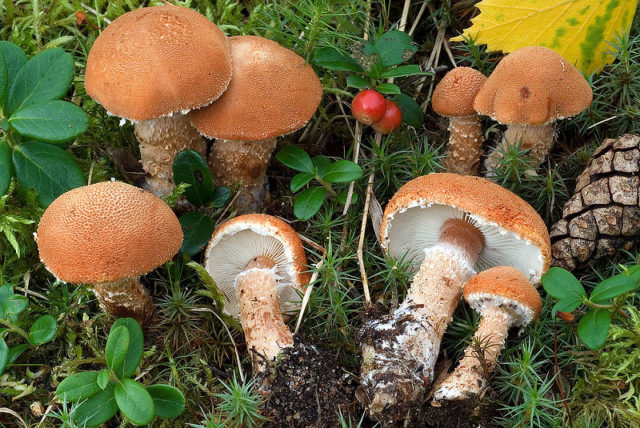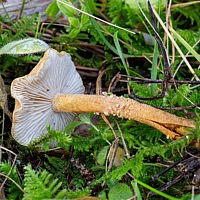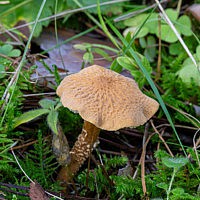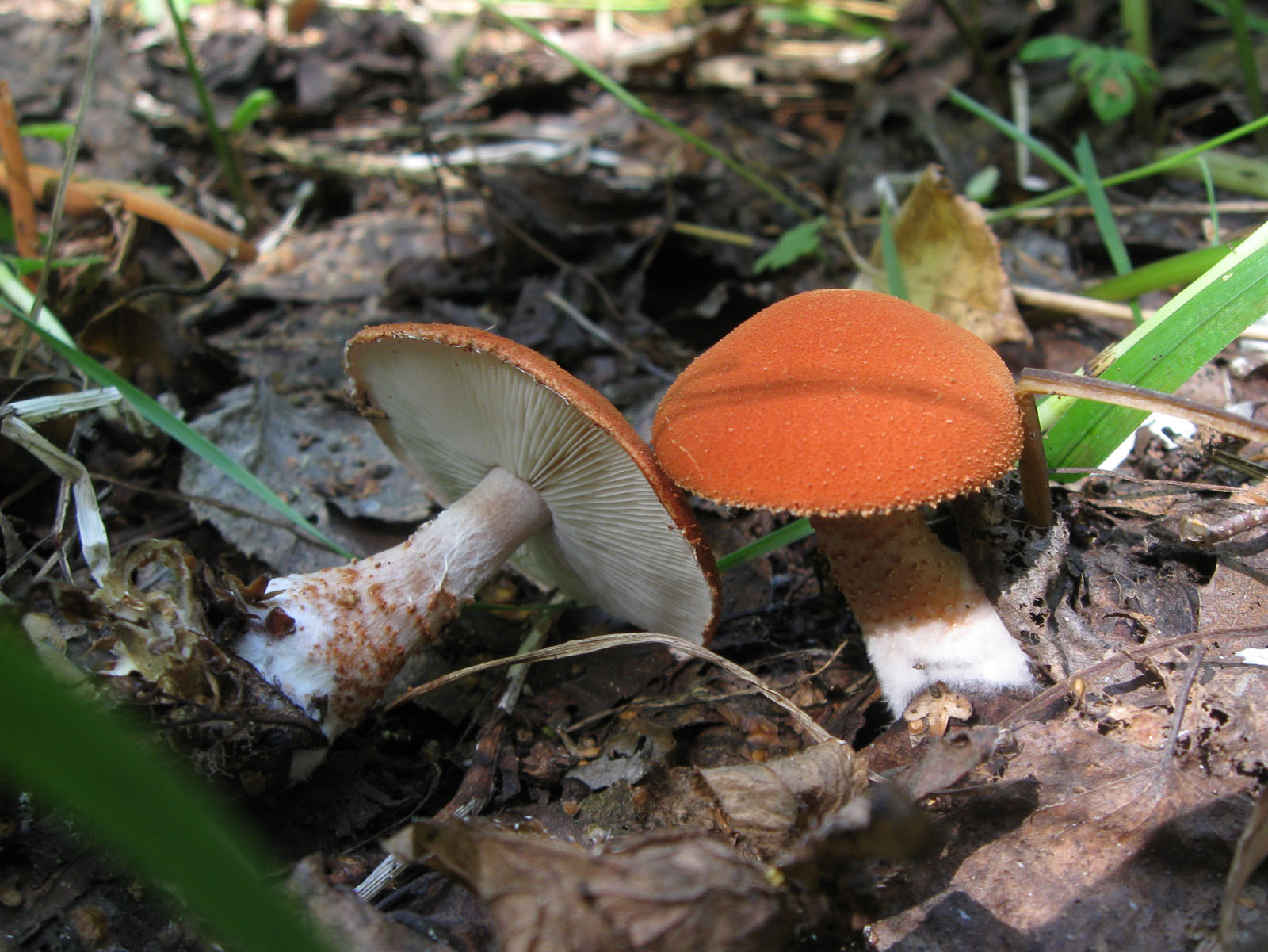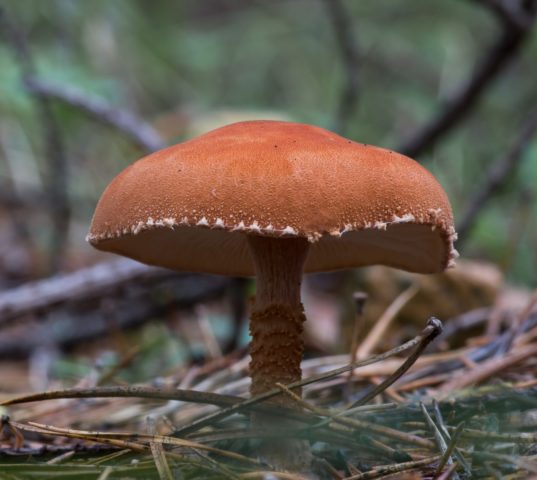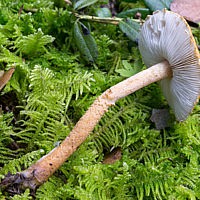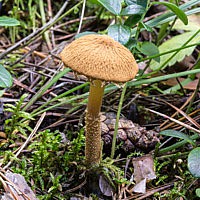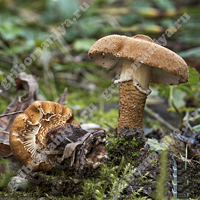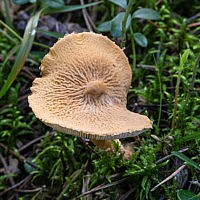Cystoderm red (cinnabar red, Umbrella red, Cystodermella cinnabarina): what mushrooms look like, where and how they grow, are they edible or not
The cystoderm is red, or the cystoderm is cinnabar-red, or the umbrella is red - Cystoderma cinnabarinum
Class Basidiomycetes, or Basidiomycetes - Basidiomycetes Subclass Homobasidiomycetes - Homobasidiomycetiidae Group Lamellar, or Agaric Order Lamellar, or Champignon, or Agaric - Agaricales Family Champignon, or Agaricae - Agaricae
Genus Cystoderm - Cystoderma Fayod
A rare edible lamellar mushroom, it has a pleasant mushroom smell. Boil for about 15 minutes.
It grows mainly on soil in moss or rotting wood, prefers pine forests throughout Russia, bears fruit in July-October.


In young mushrooms, the cap is convex, in mature mushrooms it is convexly spread, with the remains of the veil hanging from the edges in white flakes. Its diameter is about 8 cm. The surface of the cap is dry, fine-grained, purple in color, densely covered with small red scales.
The plates are thin, poorly adherent, first white, and then light brown.
The stem is rounded, thicker at the base, about 5 cm high and about 1 cm in diameter. Its surface at the cap is smooth, scaly at the bottom, painted white, slightly reddish at the base. On the stem of young mushrooms in its middle part there is a narrow reddish ring, which is absent in mature mushrooms.
The pulp is thin, soft, reddish-white, with a pleasant mushroom aroma.







Photo author Sergeeva Lidia Moscow region, Orekhovo-Zuevsky district
Cystodermella granulosa
Cystodermella granulosa (Cystodermella granulosa) Scientific name - Cystodermella granulosa (Batsch) Harmaja
Syn: Cystoderma granulosum
Description
The hat is 2.5-8 cm in diameter, dry, at first hemispherical with a tucked edge, evenly and densely covered with cone-shaped granules and warts, flat-convex at maturity, with a slightly uneven edge, from which the remnants of a common blanket often hang in the form of white flakes ; dark brown, cinnamon-brown, with age and in the sun fading to orange-brown, brick-red and even straw color.
The plates are adherent, frequent, slightly serrated, with plates, whitish or yellowish.
Leg - 2-9 cm long and up to 1 cm thick, dry, solid or hollow, cylindrical or expanding towards the base, one-color with a cap, with a rapidly disappearing flaky-scaly annular zone, covered with whitish to dark brown flakes below the annular zone and with a smooth, silky, slightly furrowed surface above it; often with white mycelial pubescence at the base.
The flesh is soft, whitish or creamy in the cap and brownish in the stem, with a mild taste and an indistinguishable faint odor.
Spore powder - white
Edible - the mushroom is edible, can be used similarly to Cystodermella cinnabarina, however, due to its small size and scarcity, collection for food purposes does not make much sense.
Habitat and distribution - on soil and among mosses in coniferous, mixed and deciduous forests, usually in small groups, in late summer and autumn. It can also grow on pastures, in gardens, on roadsides. It is widespread in North America and Europe (including the European part of Russia), it is also found in South America, North Africa and Asia (Siberia, the Far East, Japan, Korea, as well as Central and Southwest Asia).
Similar species
At a young or mature age and in a healthy, fresh state, the mushroom is easily identified by the cinnamon brown, without orange and red shades, the color of the cap and the same color of the leg without a ring. However, with age, the color can fade strongly, and the granules on the surface of the cap become invisible or completely disappear. In such cases, microscopy is necessary for accurate determination.The closest species, Cystodermella cinnabarina and Cystodermella adnatifolia, are very similar, but usually have bright red-orange caps and slightly lighter legs. Cystodermella ambrosii, which many mycologists consider only a variety of C. granulosum, is distinguished by snow-white fruit bodies, which, however, acquire a brownish-leathery color with age. Cystoderma amianthinum is predominantly yellow in color, ranging from straw to pale cinnamon. Cystoderma fallax can also be colored in light brown tones, but is well distinguished by a wide, showy and long-lasting ring. Cystoderma lilacipes, which has a similar brown cap, is distinguished by a purple or purple coloration of the upper part of the stem.
Doubles and their differences
There are several types of this family:
Cystoderm amianthus. Conditionally edible. It has a more brown color, watery pulp. The leg has no ring.
The cystoderm is red. It has a reddish or orange tint, a larger cap and a thick leg. Has a mushroom smell. Edible. It is necessary to boil
Important! Before collecting, you need to study the distinguishing features or upload a photo to your phone so as not to be confused with a poisonous mushroom.
- Death cap. Poisonous. Differences: a taller and thicker leg grows out of an egg-shaped white volva. The ring-skirt with fringe on the leg is directed downward.
Description
The hat is small, 2-5 cm ∅; in young mushrooms it is conical or hemispherical, later it is flat-convex or flat, with a blunt tubercle in the central part, with a turned, straightened or, sometimes, upwardly curved fringed edge. The color of the cap is from pale reddish-brown to ocher-yellow, darker in the center; in young mushrooms, the surface of the cap is granular and mealy, with flaky remnants of the veil along the edge, in old mushrooms it is dry, often radially wrinkled or folded
The plates are uneven, narrow, frequent, adherent to the stem, white in young mushrooms, later creamy or ocher-yellowish
Leg 3-7 x 0, 4-0, 8 cm, cylindrical or tapering upward, solid, later - hollow, fibrous, whitish above the ring, smooth, below the ring - mealy or granular, the same color with the cap. Ring remaining from a yellowish private veil, short lived, often missing
The pulp is whitish-yellowish, thin, with an unexpressed flour taste and a slight unpleasant, moldy] odor
Spore powder white or yellowish
Micromorphology
Spores 4-7 x 3-4 microns, elliptical, smooth, weakly amyloid
Color chemical reactions: In KOH, the surface of the cap is rusty red.]
Names and taxonomy
Scientific synonyms]
- Agaricus granulosus var. amianthinus (Scop.)., 1838
- Armillaria amianthina (Scop.) Kauffm., 1923
- Lepiota amianthina (Scop.) P. Karst., 1879
- Lepiota granulosa var. amianthina (Scop.) P. Kumm., 1871
Other Russian names: spinous cystoderm, amiant umbrella.]
The species was first described as Agaricus amianthinus
in 1772 by the Italian-Austrian naturalist Giovanni Scopoli. The current species name was proposed in 1889 by the Swiss mycologist Victor Fayod.]
Generic name of the mushroom Cystoderma
comes from the Greek κύστη (kysti ), bubble, blister, and δέρμα (derma ), leather; species epithetamianthinum - from αμίαντοσ (amiantos ), spotless.
Subspecies and forms
- Cystoderma amianthinum f. album (Maire) A.H. Sm. & Singer, 1945 - white hat, currently not allocated as a separate taxon;]
- Cystoderma amianthinum f. olivaceum Singer, 1945 - distinguished by the olive coloration of the caps of young mushrooms; the form is found in Siberia;
- Cystoderma amianthinum f. rugosoreticulatum (F. Lorinser) A.H. Sm. & Singer, 1945 - a form with a radially wrinkled cap, found in France, sometimes isolated as a separate species Cystoderma rugosoreticulatum (F. Lorinser) Wasser, 1978;
- Cystoderma var. longisporum (Kühner) Locq., 1945 and Cystoderma var. sublongisporum Singer, 1945, are currently identified as a separate species Cystoderma jasonis (Cooke & Massee) Harmaja, 1978.]
Habitat and distribution
Cystodermella cinnabarina is found fruiting in coniferous and deciduous forests, on ground among moss, grass and litter. Being a saprotrophic fungus, it decays dead organic matter. It has been recorded under pine (Pinus nigra, Pinus pinea), oak, spruce (Picea orientalis), fir (Abies cephalonica) and chestnut (Castanea sativa) in Greece and Turkey. Fruiting bodies appear solitary or in small groups, during the summer and autumn. It is widely distributed around the world on continents including Asia, Africa, Europe and North America, though in many places it is uncommon. The preliminary red data list of threatened British fungi lists Cystodermella cinnabarinum under the IUCN "Near Threatened" status.
Definitioner
- Basidia (Basidia)
-
Lat. Basidia. A specialized structure of sexual reproduction in fungi, inherent only in Basidiomycetes. Basidia are terminal (end) elements of hyphae of various shapes and sizes, on which spores develop exogenously (outside).
Basidia are diverse in structure and method of attachment to hyphae.
According to the position relative to the axis of the hypha, to which they are attached, three types of basidia are distinguished:
Apical basidia are formed from the terminal cell of the hypha and are located parallel to its axis.
Pleurobasidia are formed from lateral processes and are located perpendicular to the axis of the hypha, which continues to grow and can form new processes with basidia.
Subasidia are formed from a lateral process, turned perpendicular to the axis of the hypha, which, after the formation of one basidium, stops its growth.
Based on morphology:
Holobasidia - unicellular basidia, not divided by septa (see Fig. A, D.).
Phragmobasidia are divided by transverse or vertical septa, usually into four cells (see Fig. B, C).
By type of development:
Heterobasidia consists of two parts - hypobasidia and epibasidia developing from it, with or without partitions (see Fig. C, B) (see Fig. D).
Homobasidia is not divided into hypo- and epibasidia and in all cases is considered holobasidia (Fig. A).
Basidia is the place of karyogamy, meiosis and the formation of basidiospores. Homobasidia, as a rule, is not functionally divided, and meiosis follows karyogamy in it. However, basidia can be divided into probasidia - the site of karyogamy and metabasidia - the site of meiosis. Probasidium is often a dormant spore, for example in rust fungi. In such cases, probazidia grows with metabasidia, in which meiosis occurs and on which basidiospores are formed (see Fig. E).

See Karyogamy, Meiosis, Gifa.
- Pileipellis
-
Lat. Pileipellis, skin - differentiated surface layer of the cap of agaricoid basidiomycetes. The structure of the skin in most cases differs from the inner flesh of the cap and may have a different structure. The structural features of pileipellis are often used as diagnostic features in descriptions of fungi species.
According to their structure, they are divided into four main types: cutis, trichoderma, hymeniderma and epithelium.
See Agaricoid fungi, Basidiomycete, Cutis, Trichoderma, Gimeniderm, Epithelium.
Cystoderm
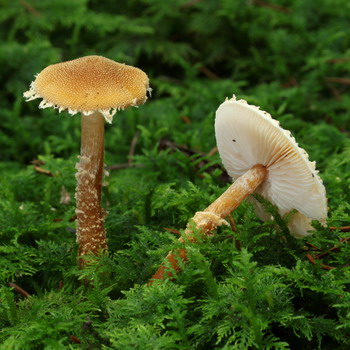
Amianthus cystoderm
Hat (diameter 2-7 cm): red, brown or yellowish, with a central tubercle and often with remnants of a veil. In young mushrooms, it has the shape of a bell, over time it becomes almost flat or slightly convex, with wrinkles or small folds. The edges are usually curved towards the inside.
Leg (height 3-10 cm): very smooth, white, tapering from bottom to top, cylindrical. Usually without a bedspread ring.
Plates: adhere tightly to the stem.
In young mushrooms, they are white, with time they become creamy or light brown.
Flesh: very thin and fragile, usually pale yellow or white in color. Smells like mold when cut or broken.
Doubles: none.

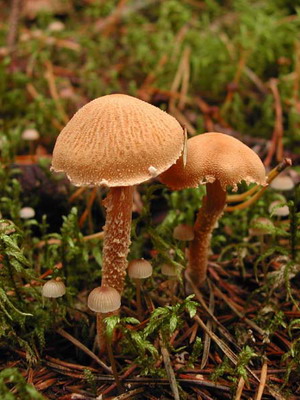
Amianthus cystoderm grows from early August to mid-October in temperate countries of the Northern Hemisphere.
Where can you find it: usually in coniferous forests, less often in mixed plantings or with ferns, in glades or parks.
Eating: not consumed, as it has an extremely low taste and an unpleasant odor.
Application in traditional medicine (data have not been confirmed and have not undergone clinical studies!): As a means for the treatment and prevention of gastritis.
Cystoderma odorous (Cystoderma carcharias)


Hat (diameter 3-8 cm): usually gray, dirty yellow or pinkish, with a large central tubercle and fringed edges, which are usually much lighter than the center. In young mushrooms, it looks like a ball or cone, in others it is more open. Dry to the touch.
Leg (height 3-11 cm): very smooth, white, tapering from bottom to top, cylindrical, with a gray or pinkish central ring.
Plates: adhere tightly to the stem. White mushrooms in young mushrooms, darken with age.
Flesh: very fragile, white or pinkish in color.
The name cystoderm comes from the Greek "sharp", "rough" or "jagged".
Twin: related species of small cystoderms, however, they tend to be more yellow.
When it grows: from mid-August to early November in temperate countries of Eurasia and North America.
Where to find it: Amianthus cystoderm is found in coniferous forests with chalky soils, usually in moss next to pine trees.
Eating: practically not consumed due to little knowledge.
Application in traditional medicine: not applicable.
Other names: scaly cystoderm, fragrant umbrella.
References
- Berkeley MJ, Broome CE (1870). "Notices of British fungi (1182-1262)". Annals and Magazine of Natural History... IV. 6: 461–69.
- Kauffmann CH. (1922). "The genus Armillaria in the United States and its relationships ". Papers of the Michigan Academy of Sciences. 2: 53–67.
- Harmaja H. (1978). "New species and combinations in the pale-spored Agaricales". Karstenia. 18: 29–30.
- ^ Ts. Hinkova (1986). Sew the Gabi (Our Mushrooms)... Zemizdat (Bulgaria). p. 95.
- ^ Sesli E. (2005). "Cystoderma cinnabarinum (Alb. & Schwein.) Fayod, a New Turkish Mycota Record. " Turkish Journal of Botany. 29 (6): 463–466.
- Saar I. (2003). "The genera Cystoderma and Cystodermella (Tricholomataceae) in temperate Eurasia ". Mycotaxon. 86: 455–73.
- ^
- Dimou D. M .; Zervakis G. I .; Polemis E. (2008). “Mycodiversity studies in selected ecosystems of Greece: IV. Macrofungi from Abies cephalonica forests and other intermixed tree species (Oxya Mt., central Greece) ". Mycotaxon. 104: 39–42.
- ^
- [dead link]
- Boa E. R. (2006). Champignons Comestibles Sauvages (Edible Wild Mushrooms) (in French). Food and Agriculture Organization of the United Nations. p. 144. ISBN 92-5-205157-0.
Granular cystoderm (Cystoderma granulosum): what mushrooms look like, where and how they grow, are they edible or not

Insert-mushroom-tree Synonyms: Agaricus granulosus Batsch, 1783 Agaricus granulosus var. albus Alb. & Schwein., 1805 Agaricus granulosus var. expallidus Alb. & Schwein., 1805 Agaricus granulosus var. ferrugineus Pers. Armillaria granosa (Batsch) Kauffman, 1923 Armillaria granulosa (Batsch) Kauffman, 1923 Cystoderma granulosum (Batsch) Fayod, 1889 Cystoderma granulosum f. albidum (Peck) A.H. Sm. & Singer, 1945 Cystoderma granulosum f. robustum A.H. Sm. & Singer, 1945 Cystoderma granulosum var. albidum (Peck) Heinem. & Thoen, 1973 Cystoderma granulosum var. occidentale A.H. Sm., 1945 Cystodermella granulosa f. robusta (A.H. Sm. & Singer) Vizzini, 2008 Lepiota granulosa (Batsch) Gray, 1821 Lepiota granulosa var. albida Peck, 1888 Mastocephalus granulosus (Batsch) Kuntze, 1891
Hat: 2.1-6.8 cm in diameter, ovoid, semicircular, flat-convex bark, blunt in the center or with a tubercle, reddish-coffee, rusty-brown, grayish, reddish-buffy, darker in the center, fading , with a denser granularity, mealy-finely granular, with a slightly wrinkled, flaky-fibrous edge.
Plates: slightly adherent, rounded at the stem, whitish, light yellowish, frequent, thin, with an even edge.
Place of growth: grows in mixed and deciduous forests, in clearings, on forest floor and soil.
Season: July - September.
Edible: edible mushroom.
DI. Samgina “Flora of spore plants of Kazakhstan. Volume XIII. 2. Agaricales "," Science "Alma-Ata, 1985.
| Now this species belongs to the genus Cystodermella. |
Notes (edit)
- According to the website Mycobank.org
- Vyacheslav Stepanov ... Cystoderma amianthinum. Mushrooms of the Kaluga region. Archived from the original on August 12, 2012. Retrieved June 20, 2011.
- Fayod, M.V ... Prodrome d'une histoire naturelle des Agaricinés //Annales des Sciences Naturelles, Botanique ... - Paris, 1889. - B. VII. - T. 9. - S. 350-351.
- ↑ 123Kuo, M ... Cystoderma amianthinum. Archived from the original on August 12, 2012. Retrieved June 20, 2011.
- ↑ 12Lesso, Thomas ... Mushrooms. - Moscow: AST, Astrel, 2007 .-- P. 97 .-- 304 p.
- Cystoderm amianthus. Mushrooms of the Leningrad Region. Archived from the original on August 12, 2012. Retrieved June 20, 2011.
- Cystoderm amianthus. Mushrooms of the middle lane. Archived from the original on August 12, 2012. Retrieved June 20, 2011.
Cystoderm red (cinnabar red, Umbrella red, Cystodermella cinnabarina) as they look
Cystoderm red (Umbrella red): photo and description
| Name: | Cystoderm is red |
| Latin name: | Cystodermella cinnabarina |
| View: | Edible |
| Synonyms: | Cystoderm cinnabar red, Umbrella red, Cystoderma cinnabarinum |
| Specifications: |
|
| Systematics: |
|
Red cystoderm is an edible member of the Champignon family. The species has an attractive red color and prefers to grow from July to September among spruce and deciduous trees. In order not to make an error during mushroom hunting and not to put false twins in a basket, it is necessary to analyze the external characteristics of the species.
How does cystoderm look like red
Red cystoderm is a bright, but rarely seen species of the mushroom kingdom. To recognize it and not be confused with toxic twins, you need to know the description of the mushroom and get to know its photo well.

Description of the hat
The cap is small, no more than 8 cm in diameter. In young specimens, it has a bell-shaped appearance; in adulthood, it straightens, leaving a small mound in the very center. The bright orange surface is decorated with smooth, fine-grained, red scales.
The spore layer is formed by thin often whitish or coffee-colored plates. The plates are fragile, partially adhered to the stem. The species reproduces by elongated spores.
Leg description
The leg is elongated, up to five centimeters long. In the middle, it is hollow and fibrous, thickens downward. The surface is covered with countless granular scales of pink or light red color. It becomes discolored as it grows.
Eat a mushroom or not
This representative is edible, has a whitish pulp with a pleasant mushroom aroma and taste. Before cooking, the collected mushrooms are boiled in a matter of minutes, fried, stewed and canned.
Where and how it grows
Cystoderm prefers to grow among coniferous trees in small families, less often single specimens, in regions with a climate of temperate latitudes. Begins fruiting from July to early October. Mushroom picking is best done in dry, sunny weather, away from highways and industrial enterprises.
Doubles and their differences
This representative has similar twins. These include:
- Grainy - a conditionally edible species with an ovoid brown-orange cap. The pulp is dense, odorless and tasteless. It grows in coniferous forests in small families. Fruiting comes from August to October.
- Amiantovaya is a conditionally edible mushroom with a small convex cap and a long cylindrical stem. The pulp is light, tasteless, but with a faint offensive odor. Grows among conifers and deciduous trees from August to October.
Conclusion
Red cystoderm is an edible representative of the mushroom kingdom. It can often be found in coniferous forests from July to October. Before cooking, the collected mushrooms are thoroughly soaked and boiled. Prepared cystoderms are good fried, stewed and canned. Skilled mushroom pickers recommend passing by little-known specimens so as not to harm yourself and your own family.
Description

View of the cap, gills, and stem
The cap is hemispherical in shape at first, becoming convex and finally flat with maturity, and reaching a diameter of up to 8 cm (3.1 in). The cap cuticle is cinnabar, brick-red or rusty orange and densely covered with fine granules. The flesh is white to pallid, with a mild fungoid taste and barely discernible smell. The gills are white to cream, dense and emarginate or adnate. A finely cottony partial veil covers the gills in immature specimens, tearing away to leave behind a delicate ring. The stem is white above the ring, and scaly below, with dark orange squamules. The stem is up to 6 cm (2.4 in) tall and 1.5 cm (0.6 in) in diameter, sometimes bulbous in the base and hollow.
Microscopic characteristics
The basidiospores are oval, hyaline, and non-amyloid, with dimensions of 3.5–5 by 2.5–3.5 µm. The spore print is white. The basidia (spore-producing cells) are club-shaped, and 17-24 by 4-5 µm. C. cinnabarina always has cells called cheilocystidia — cystidia that are present on the edges of gills, which in this species are spear-shaped. This microscopic feature may be used to help distinguish it from the similar-colored C. adnatifolia and C. granulosa, which also bear non-amyloid spores, but lack cystidia.
Species of Cystoderma (including orange-capped species such as Cystoderma amianthinum) have amyloid spores, in comparison to non-amyloid spores in C. cinnabarina and species of Cystodermella in general. This is determined by staining tissue with chemicals in the amyloid reaction — all Cystodermella species show a negative reaction (spores remain colorless).
Description
- The cap is semicircular or rounded-bell-shaped, later convex-outstretched, covered with the remains of a bedspread, mostly along the edge.
- The plates are white, milky-cream or slightly yellowish in color, with an even edge, adhered to the stem or weakly descending onto it, unequal.
- The pulp is non-amyloid.
- The stem is central, thin, covered with the remains of a blanket consisting of spherocysts; in its upper part there is a ring-shaped formation.
- The spore powder is whitish or pale cream. Spores are round, ellipsoidal, broadly or elongated-ellipsoidal, thin-walled, amyloid or non-amyloid, occasionally pseudoamyloid.
Ecology
- They grow on soil in forests or outside forests, in moss, sometimes on wood dust.
- Cosmopolitans are found on all continents, including Antarctica.
Hebeloma sticky, false value
Hebeloma glue
Hebeloma crustuliniformes
Description. The hat is 4-15 cm in diameter, at first hemispherical, then convex or flat-spread, with an even flat edge, naked, yellowish-brown, sometimes darker in the center. Plates with a notch or adherent, yellowish-brown, in wet weather with drops of liquid, when dry, with spots in place of drops. Leg 3-12 × 0.8-2.5 cm, dense, hollow with age, whitish, turns yellow over time, slightly swollen at the base. The pulp is white at first, creamy over time, with a radish smell, bitterish.
Growth. Grows in deciduous and mixed forests.
Fruiting. Forms fruiting bodies in August - November.
Usage. Inedible mushroom.
Description
The cap is hemispherical in shape at first, becoming convex and finally flat with maturity, and reaching a diameter of up to. The cuticle of the cap is cinnabar, reddish brown or rusty orange and densely covered with fine granules. The flesh is white to pale with a moderate mushroom taste and barely noticeable odor. The gills are white to froth, dense and emarginate or fused. A fine cotton partial veil covers the gills in immature specimens, tearing off to leave a thin ring behind.The base is white above the ring and scaly below with dark orange squamules. The stem was tall and in diameter, sometimes convex at the stem and hollow.
Microscopic features
basidiospores are oval, hyaline, and non-starchy, 3.5–5 by 2.5–3.5 µm in size. Spore white print. Basidia (spore-producing cells) are club-shaped, and 17-24 by 4-5 microns. Have C., cinnabar always, there are cells called cheilocystidia - cystidia, which are present at the edges of the gills, which are spear-shaped in this species. This microscopic feature can be used to help distinguish it from C. similar color adnatifolia and C. granulosawhich also have non-starchy spores but lack cystidia.
varieties Cystoderma (including orange-surprised varieties such as Cystoderma amianthinum) there are starchy spores, compared to non-starchy spores in cinnabar C. and varieties Cystodermella generally. It is determined by dyeing fabric with chemicals in a starchy reaction - all varieties Cystodermella show a negative reaction (spores remain colorless).
Conclusion
The scaly cystoderm is an exotic mushroom. Therefore, it is better for novice mushroom pickers not to risk collecting them. Only an experienced lover of quiet hunting can be sure that he has taken the “right” specimen.

